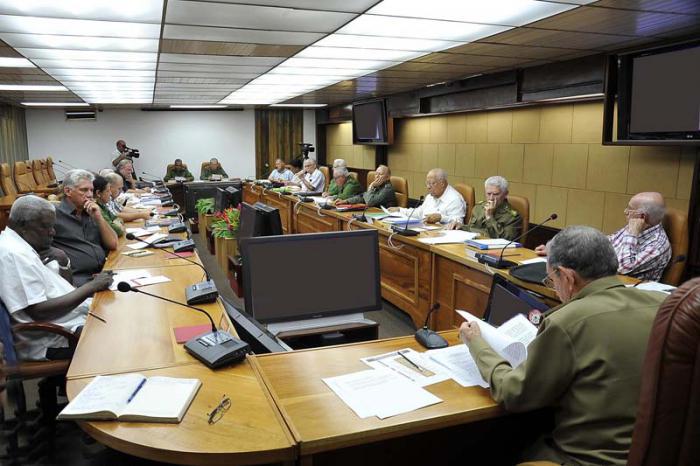
The President of the National Defense Council, Army General Raúl Castro Ruz, led a meeting with Party, state and government leaders on Wednesday, September 13, during which the damages caused by Hurricane Irma were evaluated, and the actions to be undertaken during the recovery phase outlined.
Raúl recognized the hard work in each of the areas affected by the devastating meteorological event, which struck virtually the entire island. He noted that if any benefit can be obtained from this difficult situation, it is to immediately collect experiences to better prepare for future events of this nature.
The President warned that the present hurricane season, which has been described as intense, extends until November 30, an evident product of climate change and to which we must adapt.
The Army General called to continue working tirelessly to calmly resolve problems and to keep the people informed by all possible means on the situation facing the country.
During the meeting it was highlighted that given Irma’s path across several provinces, authorities were forced to evacuate to 1,738,000 people, of them 86% were sheltered in the homes of neighbors and relatives. The head of the National Civil Defense General Staff, Major General Ramón Pardo Guerra, reported that more than 26,000 people remain in evacuation centers.
As he noted, the National Office of Statistics and Information is working to assess the damages, and preliminary figures are expected to be released in the coming days.
Alfredo López Valdés, minister of Energy and Mines, stated that the Antonio Guiteras thermoelectric power station in Matanzas had suffered the strongest and most difficult impact to be solved in this sector, as its sea water supply system, a key element in the cooling process, was destroyed by huge storm surges.
Highly specialized staff are working to compensate for damages and to ensure the plant is back in operation in the next few days.
In addition, 15 transmission lines suffered damages, and more than 3,600 posts and 2,039 kilometers of power lines were affected. Work is ongoing day and night to restore service, the minister stressed, emphasizing that this was the first time the power system had ceased to operate throughout the entire country.
Around 90 oil wells, located on the north coast of the western and central regions, were also damaged by the storm surges caused by the hurricane.
López Valdés praised the work of the mixed brigades which, on orders of the Army General, were created in the affected territories for debris clearing, tree pruning, and the transportation of utility poles.
Finally, he explained that the major efforts to restore electricity are concentrated in the provinces of Villa Clara and Ciego de Ávila, territories with the most complex impacts.
Meanwhile, the Ministry of Construction is participating in the recovery efforts with more than 20,400 construction workers and 855 engineering machines, devoted to debris collection, the repair of roads, bridges and drains, as well as the repair of housing and public buildings.
Sector Minister René Mesa Villafaña noted that the major impacts of the hurricane were concentrated on housing, especially damage to roofing. Although the exact figures regarding the damage are not yet available, efforts are already underway to help those whose homes were destroyed, for which cement and roof tile factories are producing at full capacity. The Camagüey tile factory is also expected to begin operations in the coming days.
Meanwhile, the most serious damages to agriculture were seen in the poultry sector, as dozens of egg production sheds lost their roofs. Julio A. García Pérez, first deputy minister of Agriculture, explained that the production of feed, plantain and corn crops, as well as fruit trees, have also been affected.
Work is now intensifying in the reactivation of the varied crops campaign, for which, he said, seeds, fertilizers and pesticides are available.
On this point, José Ramón Machado Ventura, a vice president of the Councils of State and Ministers, considered that, despite the damages, the agricultural sector is in better conditions than in previous situations to recover from Irma’s impact.
Public Health Minister Roberto Morales Ojeda reported that the health system maintained services during the passage of the hurricane, and that to date there have been no outbreaks of communicable diseases in evacuation centers or any territory. Regarding Cuban collaborators working in the Caribbean countries hit by the cyclone, he noted that they are well and have joined the recovery efforts in these islands.
Ojeda revealed that 516 health units were damaged, and work is underway to restore them in the shortest possible time. He added that the current priority is environmental sanitation and vector control, for which all necessary resources are available.
Finally, regarding the effects on tourism, sector Minister Manuel Marrero Cruz explained that more than 51,000 vacationers were on the island when the hurricane hit, of these some 45,000 were located on the northern coast. About 10,000 tourists were evacuated from the Santa María, Coco and Guillermo keys.
He noted that the damaged infrastructure is being repaired, to ensure it is ready for the upcoming high season beginning in the first half of November.
On closing the meeting, President Raúl reiterated the need to deal with problems intelligently, taking into account the best experiences put into practice in the face of similar events, especially at the local level. In this regard, he mentioned the efforts deployed in Santiago de Cuba and Guantánamo, following the impact of hurricanes Sandy in 2012, and Matthew in 2016, respectively.
This time the impact has been very strong and spread throughout most of the country, he said, but with the hard work that is being done, we’ll come through this once again. (Taken from en.granma.cu)